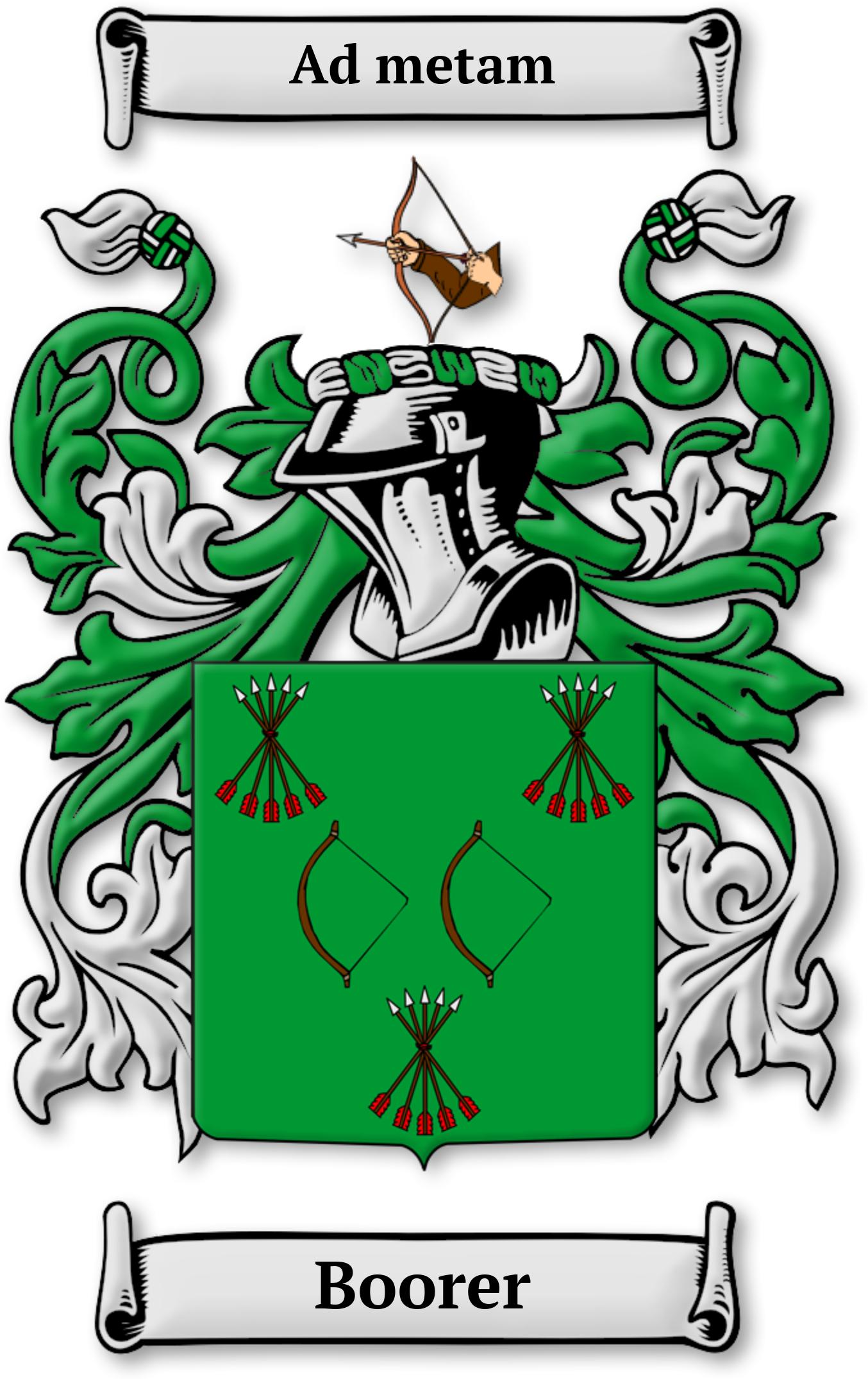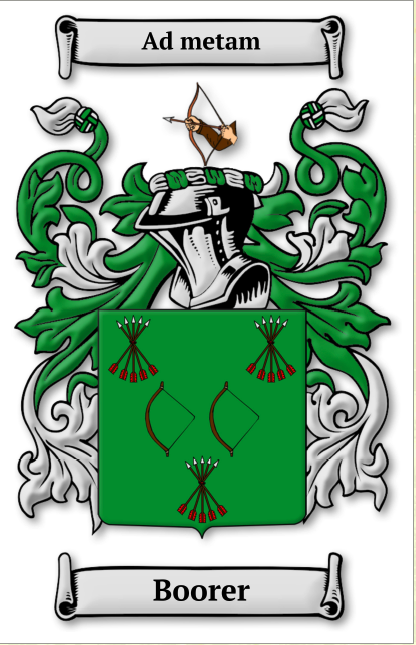
The Most Distinguished Surname Boorer
Table of Contents
Surname History
Ancient Origins
Ancient History
Spelling Variations
Early History
Early Notables
Life in Ireland
The Great Migration
Current Notables
Historic Events
Surname Symbolism
Further Readings and Bibliography
Ancient Origins
In Scotland, the name Boorer is generally derived from the Scots word “bowar,” which means “bow maker;” and as such was an occupational name. The name also evolved from the Middle English word “bur,” or “bour” meaning a “cottage,” or an “inner room;” in which case it was a topographic name for someone who lived in a small cottage, and also an occupational name for a servant of the inner rooms of a manor.
Ancient History
The Border region of England and Scotland produced some of the most illustrious family names the world has ever known, names such as Armstrong, Nixon, Graham, Bell, Carson, Hume, Irving, Rutherford, and of course, Boorer.
Professional analysts have researched the history of lowland Scotland and northern England, including many private collections of genealogical records, the Inquisitio, the Exchequer Rolls of Scotland, the Ragman Rolls, The Hearth Rolls, the Domesday Book, parish cartularies, baptismals, and tax rolls, and revealed that the first record of the name Boorer was found in Peeblesshire (Gaelic: Siorrachd nam Pùballan), former county in South-central Scotland, in the present day Scottish Borders Council Area, where they held a family seat in the old manor of Bower in the parish of Drummelzier.
One of the first records of the family was “Lorence atte Bure of the county of Peebles, and William Oftherebure of the county of Roxburgh[who] rendered homage[to King Edward I of England] in 1296.” [1]
Spelling Variations
Many different spellings of the Boorer name were found: some deliberate, some quite accidental. The Boorer surname could also be found spelled Bower, Bowre, Bowyr, Bowers, Bowyer, Beauer and Bowier, and these variations in spelling would change and evolve over time; sometimes, even between father and son. Scribes and church officials recorded the name from its sound, sometimes changing the spelling on each occasion of the same person’s birth, death or marriage.
Early History
The family name Boorer is believed to be descended originally from the Strathclyde Britons. This ancient, founding race of the north was a mixture of Gaelic/Celts whose original territories ranged from Lancashire in the south, northward to the south bank of the River Clyde in Scotland. From 400 A.D. to 900 A.D. their territory was overrun firstly by the Irish Gaels, then the Angles from the east, and, finally the Picts and Dalriadans from the north. However, their basic culture remained relatively undisturbed. By 1000 A.D., the race had formed into discernible Clans and families, perhaps some of the first evidence of the family structure in Britain.
By the 16th and 17th centuries many of our modern family names descended directly from this ancient race, including Boorer. Tracing its ancient development, the name Boorer was found in Peebles. In 1296, William Bower of Roxburghshire rendered homage to King Edward 1st of England.
Although there was a profession known as a ‘Bower’, a bowmaker, a very important profession before the advent of the musket, there does not appear to be much evidence that the family name and profession were connected with one another after the 11th or 12th century.
The surname had already branched northward to Aberdeen, and Roger Bower held land and territories in Cuykstoll in Aberdeen in 1317. John Bower was a monk in Arbroath in 1387. However, not all the Bowers were quiet and peaceful. Patrick Bower was forgiven for his participation in burning the town of Dunbarton in 1489, and Thomas Bower lost his lands and title for his part in defending Dunbar Castle against the King of Scotland in 1479. They branched south to Welham and Scorton in the East Riding of Yorkshire, and also acquired Iwern House in Dorset. By 1615 they had also acquired Oxenfield in Durham.
Early Notables
Notable amongst the family at this time was Walter Bower or Bowmaker (d. 1449), Abbot of Inchcolm, reputed continuator of Fordun’s ‘Chronica Gentis Scotorum,’ as it appears in the volume generally known as the ‘Scotichronicon.’
Archibald Bower (1686-1766), was a Scottish author of the ‘History of the Popes,’ born on 17 Jan. 1685 at or near Dundee; according to his own account, he was descended from an ancient family which had been for several hundred years possessed of an estate in the county of Angus in Scotland. In 1702 he was sent to the Scotch college at Douay; afterwards proceeded to Rome, and was there admitted into the Society of Jesus on 9 Dec. 1706. His own statement that he was admitted into the order in November 1705 is evidently untrue, as is shown by the entry in the register of the Roman province of the society. [2]
George Bower or Bowers (fl. 1681), was an early medallist who worked principally in the reigns of Charles II and James II, and for a short time under William III. In January 1664 he was appointed ’embosser in ordinary’ (engraver) to the Mint, an office which he continued to hold till his death in the early part of 1689. [2]
Bathsheba Bowers (1671-1718), was an American Quaker author and preacher.
Life In Ireland
The border of England and Scotland was created on a line from Carlisle to Berwick in the East. Many Strathclyde families straddled the border but continued to be unified clans, powers unto themselves.
After 1000 A.D., border life was in turmoil. In 1246, six Chiefs from the Scottish side and six from the English side met at Carlisle and produced a set of laws governing all the Border Clans. These were unlike any laws prevailing in England or Scotland or, for that matter, anywhere else in the world. For example, it was a far greater offence to refuse to help a neighbour recover his property, wife, sheep, cattle or horses than it was to steal them in the first place. Hence the expression “Hot Trod,” or, a hot pursuit, from which we get the modern “hot to trot.” For refusal of assistance during a “Hot Trod,” a person could be hanged on the instant, without trial. Frequently, the descendants of these clans or families apologetically refer to themselves as being descended from `cattle or horse thieves’ when, in fact, it was an accepted code of life on the border.
In 1603, the Union of the Scottish and English crowns became reality under King James VI of Scotland, who was also crowned King James 1st of England. The Crown dispersed these “unruly border clans,” clans which had served loyally in the defense of each side. The unification of the governments was threatened and it was imperative that the old “border code” should be broken up. Hence, the Border Clans were banished to England, northern Scotland and to Ireland. Some were outlawed and banished directly to Ireland, the Colonies and the New World.
Some of the Border Clans settled in Northern Ireland, transferred between 1650 and 1700 with grants of land provided they “undertook” to remain Protestant. They became known as the “Undertakers.” Many became proudly Irish. In Ireland this distinguished family settled in County Sligo where it was sometimes mistranslated as Boar.
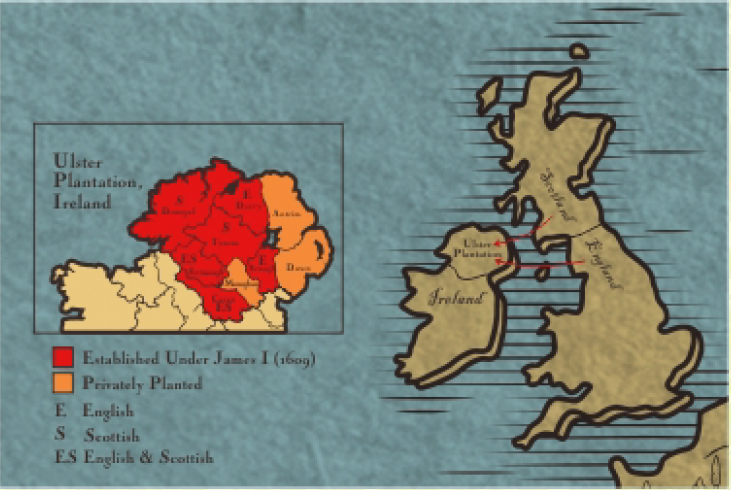
The Great Migration
Some looked to the New World and sailed aboard the “White Sails” an armada of sailing ships such as the Hector, the Rambler, and the Dove which struggled across the stormy Atlantic. Some ships lost thirty or forty percent of their passenger list. Migrants were often buried at sea having died from diseases and the elements.
Settlers
There are 167 settlers with similar origins in the Appendix.
Current Notables
In later years in North America, the immigrants formed wagon trains westward, moving to the prairies or the west coast. During the American War of Independence those who remained loyal to the Crown moved north into Canada and became known as the United Empire Loyalists. There are 49 notables with similar origins in the Appendix.
Historic Events
There are 6 historic event entries in the Appendix.

Symbolism
The practice of using symbols to represent people is ancient, and in Scotland it evolved into a complex system of armory. Although greatly influenced by England’s example, Scotland’s heraldic tradition also developed on its own, and there are many devices that are uniquely, and sometimes, exclusively Scottish.
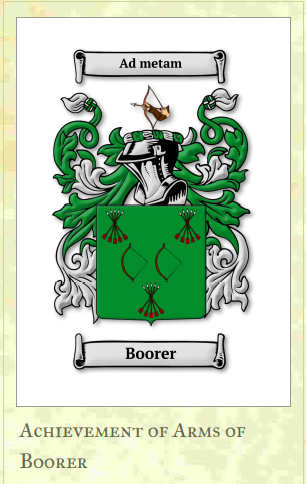
An Achievement of Arms such as the Boorer arms depicted on the left typically consists of these parts: the Escrolls, displaying the family motto and name, the family crest (if any) seen above the helmet, the actual Coat of arms (also known as ‘arms,’ or ‘the shield’), the Helmet depicted below the crest, the Torse on top of the helmet, and the Mantle draped from the helmet. Each of these elements will be described below. Supporters were a later addition to the Achievement; they are somewhat rare, and are usually personal to the grantee.
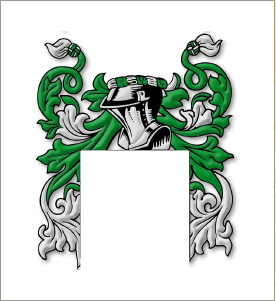
The mantle was spread over and draped from the helmet and served as a protection, ‘to repel the extremities of wet, cold, and heat, and to preserve the armour from rust.’ The numerous cuts and slits suggest that it had been torn and hacked on the field of battle. The style or design of the mantling is up to the individual heraldic artist, and it is usually depicted in the main color and metal from the shield. The helmet (or Helm) varied in shape in different ages and countries, often depicting rank. The Esquire’s Helm, as depicted here, is generally shown silver, with a closed visor and facing to the dexter (its right). On top of the helmet is a Torse or wreath which was formed by two pieces of silk twisted together. Its purpose was to hold the crest and mantle on the Helm.
Motto
The motto was originally a war cry or slogan. Mottoes first began to be shown with arms in the 14th and 15th centuries, but were not in general use until the 17th century. Thus the oldest coats of arms generally do not include a motto. Mottoes seldom form part of the grant of arms: Under most heraldic authorities, a motto is an optional component of the coat of arms, and can be added to or changed at will; many families have chosen not to display a motto.
The motto for the Boorer coat of arms displayed here is: Ad metam
This translates as: To the mark.
Shield
Shields (or Escutcheons) at first were painted simply with one or more bands of color or ‘ordinaries’. Later, the ordinaries were used in conjunction with other figures or symbols. The Coat of Arms for the surname Boorer can be described as follows:
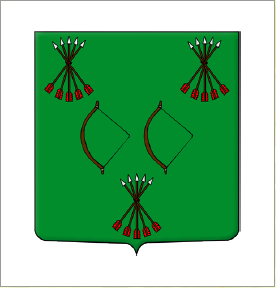
BOORER ARMS
A green shield with two bows proper, stringed silver between three sheaves of arrows.
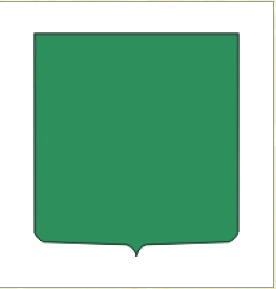
GREEN SHIELD
“Vert” (from the French word for green) signifies felicity and pleasure. It was symbolic of joy, youth and beauty. Green was also associated with the spring. The bearer of the green is obliged to defend the peasant and all who work on the land. It is expressed in engravings by lines in bend, or slanting to the right.
Symbolic Virtues: Green denotes the virtues of charity and hope, as well as the qualities of honor, courtesy and abundance.
Precious Stone: Emerald
Planet: Venus
Obligations: To defend the peasant and all who work on the land
PROPER
The term “proper” describes a charge, or a symbol on a crest or shield, depicted in its natural colours. Certificate No.
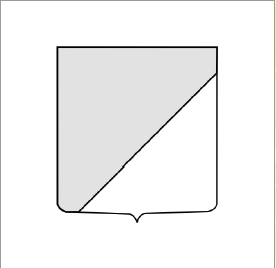
SILVER
Argent (from the French for silver), or Silver is one of the two metals used in heraldry. It is usually represented on a shield by the colors gray or white.
This metal represents nobility, peace and serenity. It is associated with the qualities of purity and chastity, because the metal withstands the test of fire.
THREE
“Three” devices, beasts or ordinaries of the same have a special significance in heraldry. First of all, there is the obvious reference to the Trinity in the design that would signify observance of the Christian doctrine.
Secondly, with many Arms it brings balance that is steeped in tradition. To better understand this latter scenario, we must look at the evolution of shield in personal armory. Kite shields that were the most popular from the the 10th-14th century evolved into Heater shields that had flat tops c. 1250. This was the time of heraldry’s beginnings and when “three” objects were used for balance in each corner of the shield. Later, with the advent of the “chief,” “chevron” and “bend” three devices brought balance to these ordinaries too.
The Crest
The Crest was worn on top of the helmet, and was usually made of wood, metal, or boiled leather. It provided the double advantage of easy identification and the addition of height to the wearer. The Crest for the surname Boorer is described as follows:
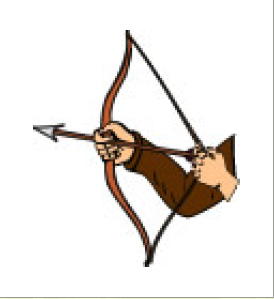
Two arms shooting an arrow from a bow all proper.

ARROW
The Arrow is said to be a weapon “destined for avengement.” Arrows and arrowheads alone symbolize martial readiness.
In the case of Polish armory, bows and arrows signify a man resolved to challenge himself to the utmost in battle, and who has prepared himself to the fall in the fight. Arrowheads without barbs, but still having space between the shaft and the arrow itself, are termed “broad arrows,” and this distinction is very stringently adhered to. Another type of arrow is the bird bolt, a short, blunt arrow used with the crossbow. It signifies that its bearer is always prepared for war.
A similar charge is the Dart, said to represent a person of dexterity and nimbleness of wit that is able to penetrate and understand matters of the highest consequence. Devices associated with warfare and military defense are frequently found in heraldry.
“In the Scriptures arrows are sometimes referred to as emblems of affliction.” [3]
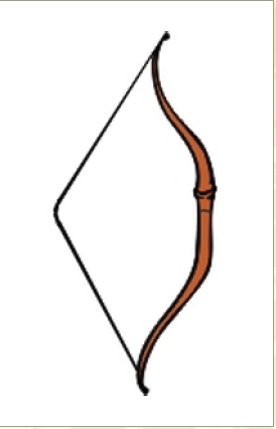
BOW
The bow is an emblem of God’s power. It is a weapon “destined to avengement.” Bows and arrows may signify a man resolved to abide the utmost hazard of battle and who has furnished himself in full to that end, and a bow and a cross symbolizes affliction. Bows alone symbolize martial readiness.
PROPER
The term “proper” describes a charge, or a symbol on a crest or shield, depicted in its natural colors.
APPENDIX – NOTABLE LIST
Surname Variants of Boorer
- JOHN William “Johnny” Bower (1924-2017) born John William Kiszkan, Canadian hockey goaltender, inducted into the Hockey Hall of Fame in 1976, one of the “100 Greatest NHL Players” in history
- William Joseph Boarman (1946-2021) American printer who served as the 26th Public Printer of the United States (2010-2012)
- Mr. John W. Bowers, British sheriff, who held the position of Sheriff of Nottingham, England from 1869 to 1870, he was Mayor in 1876
- Prof. Denise Ann Bower O.B.E., British Professor for Engineering Project Management at the University of Leeds, was appointed Officer of the Order of the British Empire on 8th June 2018, for services to the Engineering and Construction Industries [4]
- Romanus R. Bour, American Democratic Party politician, Alternate Delegate to Democratic National Convention from Ohio, 1916 [5]
- Justin De Witt Bowersock (1842-1922) American politician from Columbiana, Ohio, Member of the U.S. House of Representatives from Kansas (1899-1907)
- Jane Dee Bowersock (b.1935) birth name of Jane Dee Hull, an American politician, 20th Governor of Arizona (1997-2003), 16th Secretary of State of Arizona (1995-1997), 36th Speaker of the Arizona House of Representatives (1989-1992)
- J. P. Bowersock, American musician, guitarist, performer and record producer
- Glen Warren Bowersock (b.1936) American historian of ancient Greece, Rome and the Near East from Providence, Rhode Island
- Charles P. Bowers (1929-2015) American baseball talent scout and former pitcher in the Minor Leagues
- Kathryn Inez Bowers (1943-2015) American politician, Member of the Tennessee House of Representatives
- Brigadier-General James Isaiah Bowers (1897-1982) American Adjutant-General of New Jersey (1942) [6]
- John E. Bowersox (1885-1936) American stage and silent film actor
- Crystal Bowersox (b.1985) American singer-songwriter and contestant on American Idol
- Albert A. Bouwers (1893-1972) Dutch optical engineer
- Captain Kenneth D. Bowersox (b.1956) former NASA Astronaut with over 211 days in space [7]
- Thomas Bower (1838-1919) English architect particularly associated with the Gothic Revival style of architecture
- Graham Bowers (b.1943) Welsh avant-garde composer and painter
- Bryan Bowers (b.1940) American musician, autoharp virtuoso
- Sir William Bower (1840-1928) English merchant and politician
APPENDIX – HISTORIC EVENT LIST
Flight 191
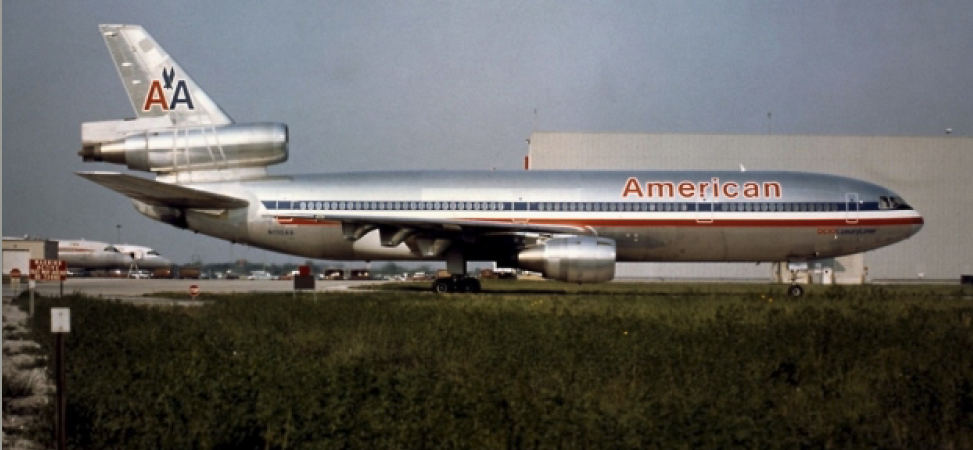
American Airlines Flight 191 traveling from O’Hare International Airport, Chicago, USA to Los Angeles International Airport, Los Angeles, California, USA on May 25, 1979 when the Left Wing engine number 1 separated causing the plane to crash killing all 258 passengers and 13 crew traveling aboard the McDonnell Douglas CD-10-10.
Surname Variants of Boorer
E Bower, American passenger from Newport Beach, California, USA, who flew aboard American Airlines Flight 191 and died in the crash [8]
Flight TWA 800
Flight TWA 800 was a Boeing 747-100 leaving from J.F.K. International Airport flying to Rome, Italy with a stopover in Paris, France on July 17, 1996 carrying 18 crew members and 20 off duty employees and 192 passengers including a French Club of students and chaperones from Montoursville High School. Approximately 8.31 pm EDT, 12 minutes after takeoff, the plane exploded and crashed in the Atlantic Ocean, many investigations followed with F.B.I. investigations and NTSB investigations it was concluded that the fuel vapors in the fuel tank exploded via a possible short circuit killing all 230 aboard the flight.
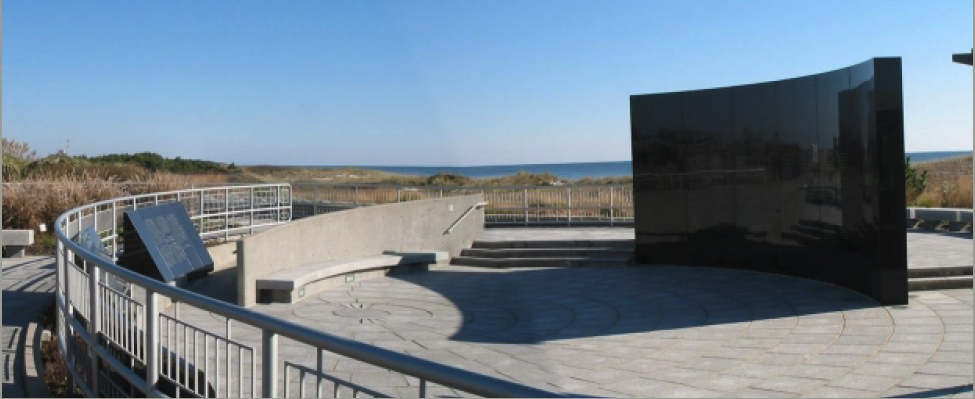
Surname Variants of Boorer
Mr. Jordon Michael Bower (1979-1996) from Montoursville, Pennsylvania, USA, American student from Montoursville flying aboard flight TWA 800 from J.F.K. Airport, New York to Leonardo da Vinci Airport, Rome when the plane crashed after takeoff ; he died in the crash [9]
HMS Hood
HMS Hood was commissioned in 1920. On May 24th 1941 she was ordered to intercept the German Battleship Bismarck with HMS Prince of Wales. Early in the Battle of the Demark Strait HMS Hood was struck and sunk after its explosion. Despite being hit she managed to strike Bismarck causing her to steer for safety, 1419 crew lost their lives in the sinking, only 3 survived. HMS Hood
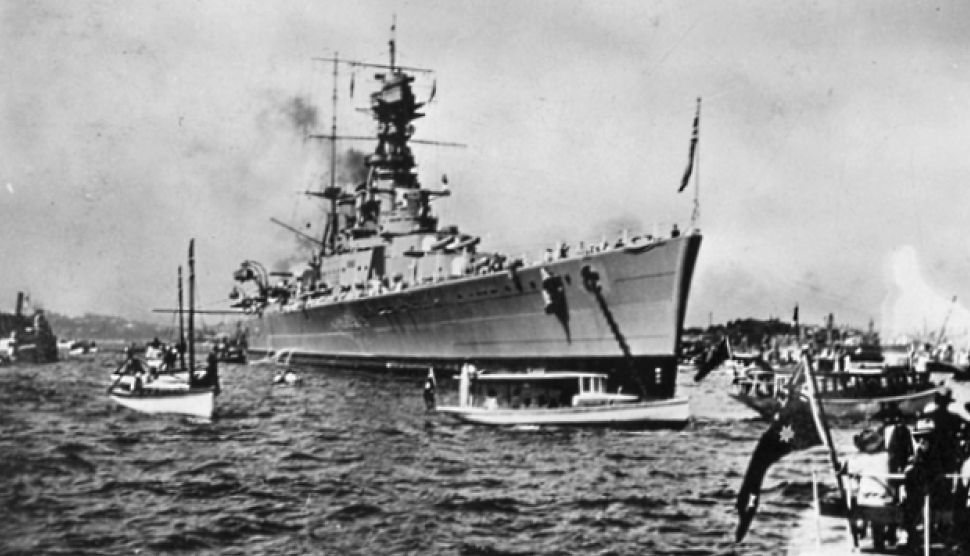
Surname Variants of Boorer
- Mr. Leo S Bowers (b.1918) English Ordinary Seaman serving for the Royal Navy from Knowle, Hampshire, England, who sailed into battle and died in the sinking [10]
- Mr. Ronald Bower (b.1920) English Stoker 1st Class serving for the Royal Navy from Marlpool, Derbyshire, England, who sailed into battle and died in the sinking [10]
- Mr. Reginald P Bower (b.1923) English Able Seaman serving for the Royal Navy from Westbourne, Hampshire, England, who sailed into battle and died in the sinking [10]
HMS Repulse
HMS Repulse was one of the world’s fastest battleships. She participated in many campaigns during her time, but eventually sunk on the 10th of December 1941 by a Japanese Aircraft. After witnessing the explosion of the HMS Hood she took torpedo fire and quickly capsized, 508 men lost their lives.
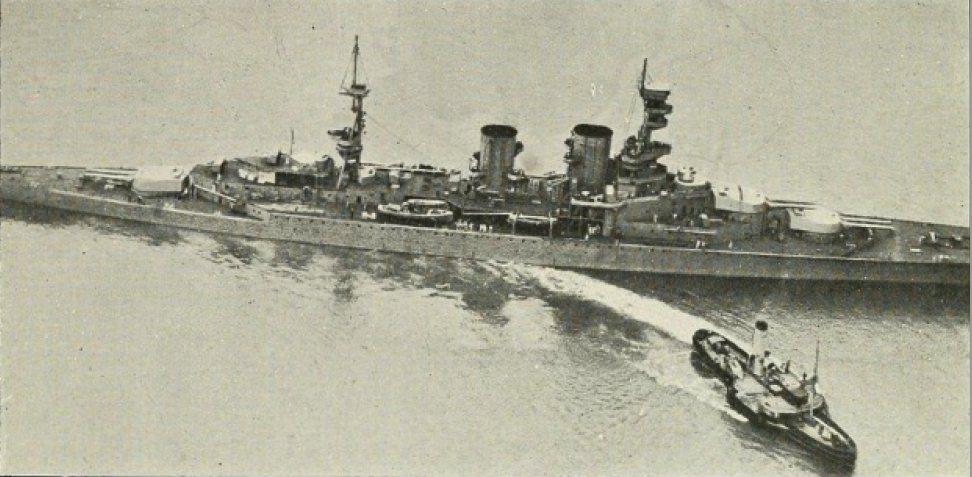
Surname Variants of Boorer
- Mr. Frank Bower, British Stoker 1st Class, who sailed into battle on the HMS Repulse and died in the sinking [11]
APPENDIX – SETTLERS LIST
Australian Settlers
Surname Variants of Boorer
- Mr. William Bowers, British convict who was convicted in Middlesex, England for life, transported aboard the “Calcutta” in February 1803, arriving in New South Wales, Australia, the settlement was listed as abandoned and most of the convicts transported to Tasmania on the “Queen” in 1804 [12]
- Mr. Isaac Bowers, British Convict who was convicted in Lincolnshire, England for life, transported aboard the “Earl Spencer” in May 1813, arriving in New South Wales, Australia [13]
- Miss Eliza Bowra, (b. 1818), aged 18, Engish servant who was convicted in Kent, England for 14 years for stealing, transported aboard the “Elizabeth” on 20th June 1836, arriving in New South Wales, Australia, she died in 1887 [14]
- Mary Bower, who arrived in Adelaide, Australia aboard the ship “Winchester” in 1838 [15]
- Thomas Bower, who arrived in Adelaide, Australia aboard the ship “Winchester” in 1838 [15]
- Jane Bower, who arrived in Adelaide, Australia aboard the ship “William Nicol” in 1840 [16]
- Thomas Wilson Bower, English convict from Cheshire, who was transported aboard the “Anna Maria” on March 6, 1848, settling in Van Diemen’s Land, Australia [17]
- J. Bower, who arrived in Adelaide, Australia aboard the ship “John Woodall” in 1849 [18]
- Frederick Bawers, who arrived in Adelaide, Australia aboard the ship “William Hyde” in 1850 [19]
- John Bower, aged 31, who arrived in South Australia in 1852 aboard the ship “Amazon” [20]
- Ellen Bower, aged 26, a farm servant, who arrived in South Australia in 1854 aboard the ship “James Fernie” [21]
- Henry John Bower, aged 35, a mason, who arrived in South Australia in 1854 aboard the ship “Star Queen” [22]
- Sarah Bower, aged 14, a servant, who arrived in South Australia in 1854 aboard the ship “Star Queen” [22]
- Julia Bower, aged 18, a domestic servant, who arrived in South Australia in 1855 aboard the ship “Northern Light” [23]
- John Bower, aged 24, a saddler, who arrived in South Australia in 1855 aboard the ship “Aliquis”
- Mr. John Bower, English convict who was convicted in Sailsbury (New Sarum), Wilsthire, England for 10 years, transported aboard the “Edwin Fox” on 24th August 1858, arriving in Western Australia, Australia [24]
New Zealand Settlers
Surname Variants of Boorer
- David Bower, aged 28, a gardener, who arrived in Otago aboard the ship “Philip Laing” in 1848
- Jean Bower, aged 22, who arrived in Otago aboard the ship “Philip Laing” in 1848
- Mr. David Bower, Scottish settler travelling from Greenock aboard the ship “Philip Laing” arriving in Otago, South Island, New Zealand on 15th April 1848 [25]
- Mrs. Bower, Scottish settler travelling from Greenock aboard the ship “Philip Laing” arriving in Otago, South Island, New Zealand on 15th April 1848 [25]
- Mr. Adam Bower, (b. 1821), aged 36, British stonemason travelling from London aboard the ship “Roehampton” arriving in Lyttlelton, Christchurch, South Island, New Zealand on 7th March 1858 [25]
- Richard Bower, who arrived in Auckland, New Zealand aboard the ship “Ida Zeigler” in 1863
- Mr. John Bowers, British labourer travelling from London aboard the ship “Victory ” arriving in Lyttelton, Christchurch, South Island, New Zealand on 17th October 1863 [25]
- Mr. Elizabeth Bowers, (b. 1839), aged 24, English domestic servant from Gloucestershire travelling from London aboard the ship “Tiptree” arriving in Lyttelton, Christchurch, South Island, New Zealand on 20th January 1864 [25]
- Mrs. Fanny Bowers, (b. 1820), aged 47, British settler travelling from London aboard the ship ‘Mermaid’ arriving in Lyttelton, Christchurch, South Island, New Zealand on 3rd January 1868 [26]
- Miss Eliza Bowers, (b. 1853), aged 14, British settler travelling from London aboard the ship ‘Mermaid’ arriving in Lyttelton, Christchurch, South Island, New Zealand on 3rd January 1868 [26]
- Miss Louisa Bowers, (b. 1856), aged 11, British settler travelling from London aboard the ship ‘Mermaid’ arriving in Lyttelton, Christchurch, South Island, New Zealand on 3rd January 1868 [26]
- Miss Sarah Bowers, (b. 1858), aged 9, British settler travelling from London aboard the ship ‘Mermaid’ arriving in Lyttelton, Christchurch, South Island, New Zealand on 3rd January 1868 [26]
- Mr. Albert Bowers, (b. 1862), aged 5, British settler travelling from London aboard the ship ‘Mermaid’ arriving in Lyttelton, Christchurch, South Island, New Zealand on 3rd January 1868 [26]
- Edward Bower, aged 51, a bricklayer, who arrived in Wellington, New Zealand aboard the ship “La Hogue” in 1874
- William John Bower, aged 17, a labourer, who arrived in Wellington, New Zealand aboard the ship “La Hogue” in 1874
- George Boarer, aged 27, a carpenter, who arrived in Wellington, New Zealand aboard the ship “Strathnaver” in 1874
- • Lydia Boarer, aged 28, who arrived in Wellington, New Zealand aboard the ship “Strathnaver” in 1874
- William C. Bower, aged 19, who arrived in Lyttelton, New Zealand aboard the ship “Ballochmyle” in 1874
- Marione Bowrey, aged 18, a nursemaid, who arrived in Auckland, New Zealand aboard the ship “India” in 1875 [26]
- Albert Bowers, aged 19, a labourer, who arrived in Hawkes Bay aboard the ship “Clarence” in 1875
- Mr. Albert Bowers, (b. 1862), aged 5, British settler travelling from London aboard
- the ship ‘Mermaid’ arriving in Lyttelton, Christchurch, South Island, New Zealand on
- 3rd January 1868 [26]
- Edward Bower, aged 51, a bricklayer, who arrived in Wellington, New Zealand aboard the ship “La Hogue” in 1874
- William John Bower, aged 17, a labourer, who arrived in Wellington, New Zealand aboard the ship “La Hogue” in 1874
- George Boarer, aged 27, a carpenter, who arrived in Wellington, New Zealand aboard the ship “Strathnaver” in 1874
- Lydia Boarer, aged 28, who arrived in Wellington, New Zealand aboard the ship “Strathnaver” in 1874
- William C. Bower, aged 19, who arrived in Lyttelton, New Zealand aboard the ship “Ballochmyle” in 1874
- Marione Bowrey, aged 18, a nursemaid, who arrived in Auckland, New Zealand aboard the ship “India” in 1875 [26]
- Albert Bowers, aged 19, a labourer, who arrived in Hawkes Bay aboard the ship “Clarence” in 1875
American Settlers
Surname Variants of Boorer
- Henry Bower who settled in Virginia in 1637
- Jonas Bowers, who settled in Virginia in 1637
- Georg Borer, who arrived in Virginia in 1637 [27]
- Jonas Bowers, who landed in Virginia in 1637 [27]
- George Bowers, who arrived in Cambridge, Massachusetts in 1644 [27]
- Matthew Bowers, who landed in Cambridge, Massachusetts in 1645 [27]
- John Bowers, who arrived in Connecticut in 1649 [27]
- William Boarman, who landed in Maryland in 1650 [27]
- Xph Bowers, who landed in Virginia in 1655 [27]
- John Bowers, who settled in Virginia in 1663
- Richard Bower, who arrived in Maryland in 1664 [27]
- Mary Bowery, who arrived in Maryland in 1667 [27]
- Samuel Bower, who landed in Maryland in 1668 [27]
- Mary Bower, who landed in Maryland in 1678 [27]
- Giles Bowers, who landed in Maryland in 1680 [27]
- Robert Bowers, who landed in Maryland in 1680 [27]
- Lars Bure, who settled in Delaware in 1693
- Lars Bure, who landed in Delaware in 1693 [27]
- Jane Borer, who landed in Virginia in 1695 [27]
- Robert Bower, who settled in Virginia in 1698
Canadian Settlers
Surname Variants of Boorer
- Marie Bure, who settled in Quebec in 1665
- Richard Bowers, who arrived in Halifax, Nova Scotia in 1749-1752
- John Bowers, who settled in St. John’s Newfoundland in 1778 [28]
- Mr. John Bower, “Adam” U.E. who settled in Canada c. 1783 [29]
- Mr. Adam Bower U.E. who settled in Ernestown, Lennox & Addington, Ontario c. 1783 [29]
- Mr. Adam Bower U.E. who settled in Fredericksburgh, Cataraqui township, [Greater Napanee], Ontario c. 1783 [29]
- Mr. Adam Bower U.E. who settled in Canada c. 1783 [29]
- Mr. Gasher Bower U.E. who settled in Fredericksburgh, Cataraqui township, [Greater Napanee], Ontario c. 1783 [29]
- Mr. Gasper Bower U.E. who settled in Canada c. 1783 [29]
- Mr. John Adam Bower U.E. who settled in Canada c. 1783 [29]
- Mr. William Bower U.E. who settled in Kingston, Ontario c. 1783 [29]
- Joseph Bowers from Bristol England settled in Harbour Grace, Newfoundland, and died in 1787 [28]
- David Bower, who landed in Canada in 1820
- Peter Bour, who arrived in Manitoba in 1876
BIBLIOGRAPHY
Here is a listing of some of the sources consulted when researching British surnames. The resources below directly or indirectly influenced the authors of our surname histories. We have most of these titles in our library, others we have borrowed or had access to. Source materials have been chosen for their reliability and authenticity. Our research into surnames is ongoing, and we are continually adding to our source library. For each surname history, we seek and refer to sources specific to the surname; these are
Scotland
Adam, Frank. Clans, Septs and Regiments of the Scottish Highlands. 8th Ed. London: Bacon (G.W.) & Co, 1970. (ISBN-10: 0- 71-794500-6)
Bain, Robert. The Clans and Tartans of Scotland. Glasgow/London: Collins, 1968. (ISBN 0-00-411117-6)
Barrow, G.W.S., ed. The Charters of David I: The Written Acts of
David I King of Scots, 1124-53, and of His Son Henry, Earl of Northumberland, 1139-52. Woodbridge, UK: The Boydell Press, 1999.
Barrow, G.W.S., ed. Acts of Malcolm IV, 1153-65. Vol. 1, Regesta Regum Scottorum, 1153-1424. Edinburgh: Edinburgh University Press, 1960.
Baxter, Angus. In Search of Your British and Irish Roots. 4th Ed. Baltimore: Genealogical Publishing, 1999.
Bede, The Venerable. Historia ecclesiastica gentis Anglorum (The Ecclesiastical History of the English People). Available through Internet Medieval Sourcebook, the Fordham University Center for Medieval Studies.
Bell, Robert. The Book of Ulster Surnames. Belfast: Blackstaff, 1988. (ISBN-10: 0-85-640416-0)
Black, George F. The Surnames of Scotland: Their Origin, Meaning, and History. New York: New York Public Library, 1946 (ISBN 0- 87104-172-3)
Bloxham, Ben. Key to Parochial Registers of Scotland From Earliest Times Through 1854. 2nd ed. Provo, UT: Stevenson’s Genealogical Center, 1979.
Brown, Peter Hume. A Short History of Scotland. Edinburgh: Oliver and Boyd, 1908.
Browne, James. The History of Scotland its Highlands, Regiments and Clans. 8 Volumes. Edinburgh: Francis A. Niccolls & Co., 1909.
Bullock, L.G. Historical Map of Scotland. Edinburgh: Bartholomew and Son.
Burke, Sir Bernard. Burke’s Genealogical and Heraldic History of
the Landed Gentry: Including American Families With British Ancestry. (2 Vols.) London: Burke Publishing, 1939.
Burke, Sir Bernard. General Armory: of England, Scotland, Ireland, and Wales. Ramsbury: Heraldry Today, 1989 (1884 edition)
Burke, Sir Bernard. Genealogical and Heraldic History of the Peerage and Baronetage, The Privy Council, Knightage and Companionage. London: Burke Publishing, 1921.
Burke, John Bernard Ed. The Roll of Battle Abbey. Baltimore: Genealogical Publishing, 2005 (1848).
Catholic Directory for Scotland. Published annually since 1829. Glasgow: Burns Publications.
Chadwick, Nora Kershaw and J. X. W. P. Corcoran. The Celts. London: Penguin, 1970. (ISBN 0-14-021211-6)
Cottle, Basil. The Penguin Dictionary of Surnames, 2nd ed. London: Penguin, 1978.
Crispin, M. Jackson and Leonce Macary. Falaise Roll: Recording
Prominent Companions of William Duke of Normandy at the Conquest of England. Baltimore: Genealogical Publishing, 1985 (1938). (ISBN 9-78-080630-0801)
Debrett, J. Debrett’s Peerage and Titles of Courtesy 1891. London: Dean and Son, 1891
Donoldson, Gordon and Robert S. Morpeth. Who’s Who in Scottish History. Wales: Welsh Academic Press, 1996 (ISBN 1-86-057005-4)
Dorward, David. Scottish Surnames. Glasgow: HarperCollins, 1995.
Elster , Robert J. International Who’s Who. London : Europa/ Routledge, Published annually since 1935.
Fairbairn. Fairbairn’s Book of Crests of the Families of Great Britain and Ireland. 4th ed. 2 volumes in one. Baltimore: Heraldic Book Company, 1968.
Fulton, Alexander. Scotland and Her Tartans: The Romantic Heritage of the Scottish Clans and Families. Godalming: Bramley, 1991. (ISBN 0-86283-880-0)
Hanks, Patricia. and Flavia Hodges. A Dictionary of Surnames. Oxford: Oxford University Press, 1988. (ISBN 0 19-211592-8)
Hinde, Thomas, Ed. The Domesday Book: England’s Heritage, Then and Now. Surrey: Colour Library Books, 1995. (ISBN 1-85833-440-3)
Holt, J.C. Ed. Domesday Studies. Woodbridge: Boydell, 1987. (ISBN 0-85115-477-8)
Hopkins, Andrea. Knights: The Complete Story of the Age of Chivalry from Historical Fact to Tales of Romance and Poetry. New York: Artabras, 1990. (ISBN 0-89660-013-0)
Innes, Thomas of Learney. Scots Heraldry: A Practical Handbook on the Historical Principles and Modern Application of the Art and Science. London: Oliver & Boyd, 1934.
Innes, Thomas of Learney. The Tartans of the Clans and Families of Scotland, 1st ed. Edinburgh: W & A. K. Johnston Limited, 1938.
Kamen, Henry. European Society, 1500-1700. London: Hutchinson, 1984. (ISBN: 0-09-156991-5)
Le Patourel, John. The Norman Empire. New York: Oxford University Press, 1976. (ISBN 0-19-822525-3)
Leeson, Francis L. Dictionary of British Peerages. Baltimore: Genealogical Publishing, 1986. (ISBN 0-8063-1121-5)
Leyburn, James Graham. The Scotch-Irish: A Social History. Chapel Hill: UNC Press, 1962. (ISBN 0-80-784259-1)
Macaulay, Thomas Babington. History of England from the Accession of James the Second. 4 volumes. New York: Harper & Brothers, 1879.
Markale, J. Celtic Civilization. London: Gordon & Cremonesi, 1976.
Marshall, George William. The genealogist’s guide to printed pedigrees. Oxford: Oxford University Press, 1885.
Martine, Roddy, Roderick Martine and Don Pottinger Scottish Clan and Family Names: Their Arms, Origins and Tartans. Edinburgh: Mainstream, 1992. (ISBN 1-85-158418-8 )
Moncrieffe, Sir Ian of That Ilk and Don Pottinger. Clan Map: Scotland of Old. Edinburgh: Bartholomew and Son, 1983.
Moncrieffe, Sir Ian of That Ilk, and David Hicks. The Highland Clans: The Dynastic Origins, Chiefs and Background of the Clans. New York: C. N. Potter, 1968.
Moody, David. Scottish Family History. Baltimore: genealogical publishing, 1994. (ISBN 0-80-631268-8 )
Papworth , J.W. And A.W. Morant. Ordinary of British Armorials. London: T. Richards, 1874.
Paul , Sir James Balfour. An Ordinary of Arms: Contained in the Public Register of All Arms and Bearings in Scotland. Second Edition. Baltimore: Genealogical Publishing, 1903. (ISBN 9-78- 080630-2737)
Prebble, John. The Highland Clearances. London: Secker & Warburg, 1963.
Reaney P.H. And R.M. Wilson. A Dictionary of Surnames. London: Routledge, 1991.
Scots Kith and Kin: And Illustrated Map, Revised 2nd Ed. Edinburgh: Clan House/Albyn
Shaw, William A. Knights of England: A Complete Record from the Earliest Time to the Present Day of the Knights of all the Orders of Chivalry in England, Scotland, Ireland, and Knights Bachelors. 2 Vols. Baltimore: Genealogical Publishing , 1971 (reprint of 1906). (ISBN 0-80-630443-X )
Skene, William Forbes Ed. Chronicles of the Picts, Chronicles of the Scots, and Other Early Memorials of Scottish History. Edinburgh: H. M. General Register House, 1867.
Teall of Teallach, Gordon and Philip D. Smith Jr. District Tartans. London: Shepheard-Walwyn, 1992. (ISBN 0 85683-085-2)
Urquhart, Blair ed. Tartans: The New Compact Study Guide and Identifier. Secaucus, NJ: Chartwell Books, 1994. (ISBN 0-7858-0050-6)
Warner, Philip Warner. Famous Scottish Battles. New York: Barnes & Noble, 1996. (ISBN 0-76070-004-4)
Williams, Dr. Ann, and G.H. Martin eds. Domesday Book: A Complete Translation. London: Penguin, 1992.
Trusted Web-Sites
British History Online: http://www.british-history.ac.uk/
United Kingdom National Archives: http://www.nationalarchives.gov.uk/
College of Arms (England): http://college-of-arms.gov.uk/
Library and Archives Canada:
http://www.collectionscanada.gc.ca/
The National Archives (USA): http://www.archives.gov/
Medieval Rolls
Where available we consult Medieval Rolls or use their information as reprinted in secondary sources.
Assize Rolls: records from court sessions
Calendarium Inquisitionum Post Mortem: Feudal inquiries, undertaken after the death of a feudal tenant in chief to establish what lands were held and who should succeed to them. Records exist from around 1240-1660.
Curia Regis Rolls (Rotuli Curiae Regis): Rolls and Records of the Court held before the king’s Justices. Variously translated and published, London 1835),
Register of the Freemen of York: list of freemen from 13th-18th century, published by the Surtees Society, Francis Collins (editor)in 1897.
Historia Regum Britanniae (“The History of the Kings of Britain”): a legendary account of British history, accredited to Geoffrey of Monmouth in around 1136.
Hundred Rolls ( Rotuli Hundredorum): various royal inquests, documents were held in the tower of London. Much was published in 1818Ragman Rolls: rolls of deeds on parchment in which the Scottish nobility and gentry subscribed allegiance to Edward I. of England, A. D. 1296.
Subsidy Rolls: taxation records from the 12th to the 17th centuries.
Pipe Rolls: rolls of the Exchequer of accounts of the royal income, arranged by county, for each financial year. Many 12th and 13th century documents have been published with indexes by the Pipe Roll Society.
have accompanied William across the English Channel. Original roll was lost.
Feet of Fines: Legal agreements, usually about property ownership
Charters: documents recording grants, usually of land recorded by the Chancery
Heralds’ visitations: 16th-17th century, county by county visits to regulate the use of arms; many published by the Harleian Society.
Surnames
Cottle, Basil. The Penguin Dictionary of Surnames, 2nd ed. London: Penguin, 1978.
Dunkling Leslie. Dictionary of Surnames. Toronto: Collins, 1998. (ISBN 0-00-472059-8)
Hanks, Patricia. And Flavia Hodges. A Dictionary of Surnames.
Oxford: Oxford University Press, 1988. (ISBN 0-19-211592-8)
Hanks, Hodges, Mills and Room. The Oxford Names Companion.
Oxford: Oxford University Press, 2002. (ISBN 019-860561-7)
Lower, Mark. Dictionary of Surnames. Hertfordshire :Wordsworth Editions, 1968 (ISBN 1-85-326916-6)
Reaney P.H. And R.M. Wilson. A Dictionary of Surnames. London: Routledge, 1991.
Magnusson, Magnus. Chambers Biographical Dictionary. 5th ed. Edinburgh: W & R Chambers, 1990
Robb H. Amanda and Andrew Chesler. Encyclopedia of American
Family Names. New York: HarperCollins, 1995 (ISBN 0-06-270075-8)
Heraldry
Brooke-Little, J.P. An Heraldic Alphabet. London: Robson, 1985. (ISBN 0-86051-320-3 PB)
Elvin, C.N. Elvin’s Handbook of Mottoes: Revised With Supplement and Index by R. Pinches. London: Heraldry Today, 1971. (ISBN 0-900455-04-7)
Foster, Joseph. Dictionary of Heraldry: Feudal Coats of Arms and Pedigrees. London: Bracken Books, 1989. (ISBN 1-85170-309-8)
Fox-Davies, Arthur. A Complete Guide to Heraldry. New York: Bonanza, 1978. (ISBN 0-517-26643-1)
Fox-Davies, Arthur. Heraldry: A Pictorial Archive for Artists & Designers. New York: Dover, 1991. (ISBN 0-48626906-X)
Koller, K. and A. Schillings. Armorial Universal. Brussels: Libraire Encyclopedique, 1951.
Parker, James. Glossary of Terms Used in Heraldry. Rutland, Vt: Tuttle, 1970. (ISBN 0-8048-0715-9)
Pine, L.G. Heraldry and Genealogy. London: Teach Yourself Books, 1970. (ISBN 0-340-05614-2)
Puttock, Colonel A.G. Dictionary of Heraldry and Related Subjects. London: John Gifford, 1970.
Uden, Grant. A Dictionary of Heraldry. London: Longmans, 1968. (ISBN 582-15471-9)
Von Volbroth, Carl-Alexander. Heraldry: Customs, Rules and Styles. London: New Orchard, 1991. (ISBN 1-95079-037-X)
Williamson, David. Debrett’s Guide to Heraldry and Regalia. London: Headline Book Publishing, 1992.
Woodcock, Thomas and John Martin Robinson. The Oxford Guide to Heraldry.
Oxford: Oxford University Press, 1988. (ISBN 0-19-285224-8)
Emigration
Bolton, Charles Knowles. Scotch Irish Pioneers In Ulster And America. Montana: Kessinger Publishing, 2006 (1910).
Bowman, George Ernest. The Mayflower Reader: A Selection of Articles from The Mayflower Descendant. Baltimore: Genealogical Publishing, 1996 (reprint)
Colletta, John P. They Came In Ships. Salt Lake City: Ancestry, 1993.
Filby , P. William an d Mar K. Meyer. Passenger and Immigarion Lists Index. In Four Volumes. Detroit: Gale Research, 1985. (ISBN 0-8103-1795-8)
Passenger Lists of Vessels Arriving at Galveston, Texas 1896-1951. National Archives, Washington, D.C.
The Norman People: And Their Existing Descendants in The British Dominions and the United States of America. Baltimore: Genealogical Publishing, 1975. (ISBN 0-8063-0636-X)
Samuelsen, W. David. New York City Passenger List Manifests Index, 1820-1824. North Salt Lake, Utah: Accelerated Indexing Systems International, 1986
Sanders, Joanne McRee ed. English Settlers in Barbados, 1637-1800. Baltimore: Genealogical Publishing,
Seary, E. R. Family Names of the Island of Newfoundland – Corrected Edition. Montreal: McGill-Queen’s University Press, 1998. (ISBN 0-7735-1782-0)
Skordas, Gust, Ed. The Early Settlers of Maryland: an Index to Names of Immigrants, Compiled from Records of Land Patents, 1633-1680, in the Hall of Records, Annapolis, Maryland. Baltimore: Genealogical Publishing Co., 1968.
Smith, Leonard H. Jr. Nova Scotia Immigrants to 1867 – Volume I. Baltimore: Genealogical Publishing, 1992.
Thomas, Wilson B. and Emily S. Wilson. Directory of the Province of Ontario. Lambertville, NJ: Hunterdon House, 1857.
Whyte, Donald. A Dictionary of Scottish Emigrants to Canada Before Confederation. Toronto: Ontario Genealogical Society, 1986. (ISBN 0-920036-09-0)
Canada
Baxter, Angus. In Search of your Canadian Roots: Tracing your Family Tree in Canada. Toronto: MacMillan, 1989. (ISBN 0-7715-9201-9)
Beddoe Alan. Canadian Heraldry. Ottawa: Royal Heraldry Society of Canada, 1981.
Bercuson, David J. and J.L. Granatstein. Collins Dictionary of Canadian History: 1867 to Present. Toronto: Collins, 1988. (ISBN 0-00-217758-7)
Canadian Almanac and Directory -Annual editions. Toronto: Grey House.
Canadian Who’s Who. Toronto: University of Toronto Press, Published annually
Colombo, John Robert. Colombo’s Canadian Quotations. Toronto: Colombo and Company, 1974.
Cook, Ramsay, Real Belanger and Jean Hamelin. Dictionary of Canadian Biography: 1921 To 1930. Toronto: University of Toronto Press, 2006 (ISBN 0-80-209087-7)
Jackson, Ronald Vern, et al. Canada 1800-1842 Census – Miscellaneous. North Salt Lake, Utah: Accelerated Indexing Systems International, 1989.
Maclean . Rose, George. A Cyclopaedia of Canadian Biography Being Chiefly Men of the Time: a collection of persons distinguished in professional and political life : leaders in the commerce and industry of Canada, and successful pioneers. Toronto: Rose, 1886.
Myers, Jan. Canadian Facts and Dates. Richmond Hill: Fitzhenry & Whiteside, 1991. (ISBN 1-55041-073-3)
Old United Empire Loyalists Lists. Baltimore: Genealogical Publishing, 1976. (ISBN 0-8063-0331-X)
Olivier, Reginald L. Your Ancient Canadian Family Ties. Logan, Utah: Everton Publishers, 1972.
Reid, William D. The Loyalists in Ontario: The Sons and Daughters of the American Loyalists of Upper Canada. Lambertville, NJ: Genealogical Publishing Co., 1973.
Reid, William D. Scottish Tradition in Canada. Toronto: McClelland and Stewart, 1976.
Scarlett, James, D. Tartan: The Highland Textile. London: Shepheard-Walwyn, 1990. (ISBN 0-85683-120-4).
Shirley, Evelyn Philip. Noble and Gentle Men of England; or, Notes Touching The Armns an dDescents of the Ancient Kinghtly and Gentle Houses of England: Arranged in their Respective Counties. Westminster: John Bowyer Nichols and Sons, 3rd Ed. 1866.
Whyte, Donald. A Dictionary of Scottish Emigrants to Canada
Before Confederation. Toronto: Ontario Genealogical Society, 1986. (ISBN 0-920036-09-0)
United States
Best, Hugh. Debretts Texas Peerage. New York: Coward-McCann, 1983 (ISBN 0-69-811244-X)
Bolton, Charles Knowles. Bolton’s American Armory. Baltimore: Heraldic Book Company, 1964.
Bradford, William. History of Plymouth Plantation, 1620–1647. Edited by Samuel Eliot Morrison. 2 vols. New York: Russell and Russell, 1968.
Browning, Charles, H. Americans of Royal Descent. Baltimore: Genealogical publishing, 2004 (1911). (ISBN 9-78-080630-0542)
Crozier, William Armstrong Ed. Crozier’s General Armory: A Registry of American Families Entitled to Coat Armor. New York: Fox, Duffield, 1904.
Egle, William Henry. Pennsylvania Genealogies: Scotch-Irish and German. Harrisburg: L. S. Hart, 1886.
Library of Congress. American and English Genealogies in the Library of Congress. Baltimore: Genealogical publishing, 1967.
Matthews, John. Matthews’ American Armoury and Blue Book. London: John Matthews, 1911.
Vermont, E. de V. American Heraldica: A Compiliation of Coats of Arms, Crests and Mottoes of Prominent American Families Settled in This Country Before 1800. New York: Heraldic Publishing Company, 1965.
Weis, Frederick Lewis, Walter Lee Sheppard, and David Faris. Ancestral Roots of Sixty Colonists Who Came to New England Between 1623 and 1650. 7th ed. Baltimore: Genealogical publishing,1992. (ISBN 0-80-631367-6)
Australia
Davison, Graeme, John Hirst and Stuart McIntyre Eds. The Oxford Companion to Australian History. South Melbourne: Oxford U. Press, 2001.
Fraser, John Foster. Australia: The Making of a Nation. London: Cassell, 1911.
Flynn, Michael, The Second Fleet, Britain’s Grim Convict Armada of 1790. Sydney: Library of Australian History, 1993. (ISBN 0-908120-83-4)
Gillen, Mollie. Yvonne Browning and Michael Flynn. The Founders of Australia: A Biographical Dictionary of the First Fleet. Sydney: Library of Australian
History 1989.
King, Jonathan. The First Fleet: The Convict Voyage That Founded Australia 1787-88. London: Secker & Warburg 1982.
New Zealand
Dictionary of New Zealand Biography: Volume one: 1769-1869. Aukland: Aukland University Press, 1990.
Dictionary of New Zealand Biography: Volume Two: 1870-1900. Aukland: Aukland University Press, 1993.
CITATIONS
Extra Credit goes to Schlapfm at http://en.wikipedia.org/wiki/File:Dunnottar_castle_ruins.jpg for the picture on the cover.
Photo Credit goes to for the “Flight 191” picture.
Photo Credit goes to https://en.wikipedia.org/wiki/TWA_Flight_800#/media/File:Twa-memorial6.jpg for the “Flight TWA 800” picture.
Photo Credit goes to https://en.wikipedia.org/wiki/HMS_Hood#/media/File:HMS_Hood_in_Sydney_Harbour.jpeg for the “HMS Hood”
picture.
Photo Credit goes to https://en.wikipedia.org/wiki/HMS_Repulse_(1916)#/media/File:HMS_Repulse_aerial_starboard_view_1918.jpg for the “HMS Repulse” picture.
- Black, George F., The Surnames of Scotland Their Origin, Meaning and History. New York: New York Public Library, 1946. Print. (ISBN 0-87104-172-3)
- Smith, George (ed), Dictionary of National Biography. London: Smith, Elder & Co., 1885-1900. Print
- Wade, Cecil W. The Symbolisms of Heraldry. London: George Redway, 2nd Edition, 1898. Print
- “Birthday and New Year Honours Lists (1940 to 2019).” Issue 62507, 28 December 2018 | London Gazette, The Gazette, Dec. 2018, www.thegazette.co.uk/honours-lists
- The Political Graveyard: Alphabetical Name Index. (Retrieved 2016, January 29) . Retrieved from http://politicalgraveyard.com/alpha/index.html
- Generals of World War II. (Retrieved 2011, October 22) James Bowers. Retrieved from http://generals.dk/general/Bowers/James_Isaiah/USA.html
- NASA Astronauts Homepage. (Retrieved 2010, September 27) Kenneth Bowersox. Retrieved from http://www.jsc.nasa.gov/Bios/htmlbios/bowersox.html
- Flight 191’s Victims – latimes. (Retrieved 2014, April 16) . Retrieved from http://articles.latimes.com/1985-08-04/news/mn-4349_1_fort-lauderdale-area
- The Washington Post Passenger List TWA Flight 800. (Retrieved 2018, February 15th). Retrieved from Http:///www.hmshood.com/crew/memorial/roh_24may41.htm
- H.M.S. Hood Association-Battle Cruiser Hood: Crew Information – H.M.S. Hood Rolls of Honour, Men Lost in the Sinking of H.M.S. Hood, 24th May 1941. (Retrieved 2016, July 15) . Retrieved from http://www.hmshood.com/crew/memorial/roh_24may41.htm
- HMS Repulse Crew members. (Retrieved 2014, April 9) . Retrieved from http://www.forcezsurvivors.org.uk/biographies/listrepulsecrew.html
- Convict Records Voyages to Australia (Retrieved 25th November 2020). Retrieved from https://convictrecords.com.au/ships/calcutta
- Convict Records Voyages to Australia (Retrieved 8th September 2021). Retrieved from https://convictrecords.com.au/ships/earl-spencer
- Convict Records Voyages to Australia (Retrieved 11th March 2022). Retrieved from https://convictrecords.com.au/ships/elizabeth
- State Records of South Australia. (Retrieved 2010, November 5) WINCHESTER 1838. Retrieved from http://www.slsa.sa.gov.au/BSA/1838Winchester.htm
- State Records of South Australia. (Retrieved 2010, November 5) WILLIAM NICOL. Retrieved from http://www.slsa.sa.gov.au/BSA/1840WilliamNichol.htm
- State Library of Queensland. (Retrieved 2015, January 8) Anna Maria voyage to Van Diemen’s Land or Port Phillip, Australia in 1848 with 190 passengers. Retrieved from http://www.convictrecords.com.au/ships/anna-maria/1848
- State Records of South Australia. (Retrieved 2010, November 5) JOHN WOODALL 1849. Retrieved from http://www.slsa.sa.gov.au/BSA/1849JohnWoodall.htm
- State Records of South Australia. (Retrieved 2010, November 5) WILLIAM HYDE 1850. Retrieved http://www.slsa.sa.gov.au/BSA/1850WilliamHyde.gif
- South Australian Register Tuesday 3 February 1852. (Retrieved 2010, November 5) AMAZON 1852. Retrieved http://www.theshipslist.com/ships/australia/amazon1852.shtml
- South Australian Register Friday 17th November 1854. (Retrieved 2010, November 5) James Fernie 1854. Retrieved http://www.theshipslist.com/ships/australia/jamesfernie1854.shtml
- South Australian Register Monday 1st January 1855. (Retrieved 2010, November 5) Star Queen 1854. Retrieved http://www.theshipslist.com/ships/australia/starqueen1854.shtml
- South Australian Register Monday 9th April 1855. (Retrieved 2010, November 5) Norther Light 1855. Retrieved http://www.theshipslist.com/ships/australia/northernlight1855.shtml
- Convict Records Voyages to Australia (Retrieved 24th January 2022). Retrieved from https://convictrecords.com.au/ships/edwin-fox
- New Zealand Yesteryears Passenger Lists 1800 to 1900 (Retrieved 26th March 2019). Retrieved from http://www.yesteryears.co.nz/shipping/passlist.html
- New Zealand Yesteryears Passenger Lists 1800 to 1900 (Retrieved 17th October 2018). Retrieved from http://www.yesteryears.co.nz/shipping/passlist.html
- Filby, P. William, Meyer, Mary K., Passenger and immigration lists index : a guide to published arrival records of about 500,000 passengers who came to the United States and Canada in the seventeenth, eighteenth, and nineteenth centuries. 1982-1985 Cumulated Supplements in Four Volumes Detroit, Mich. : Gale Research Co., 1985, Print (ISBN 0-8103-1795-8)
- Seary E.R., Family Names of the Island of Newfoundland, Montreal: McGill’s-Queen’s Universtity Press 1998 ISBN 0-7735-1782-0
- Rubincam, Milton. The Old United Empire Loyalists List. Genealogical Publishing Co., Inc, 1976. (Originally published as; United Empire Loyalists. The Centennial of the Settlement of Upper Canada. Rose Publishing Company, 1885.) ISBN 0-8063-0331-X
